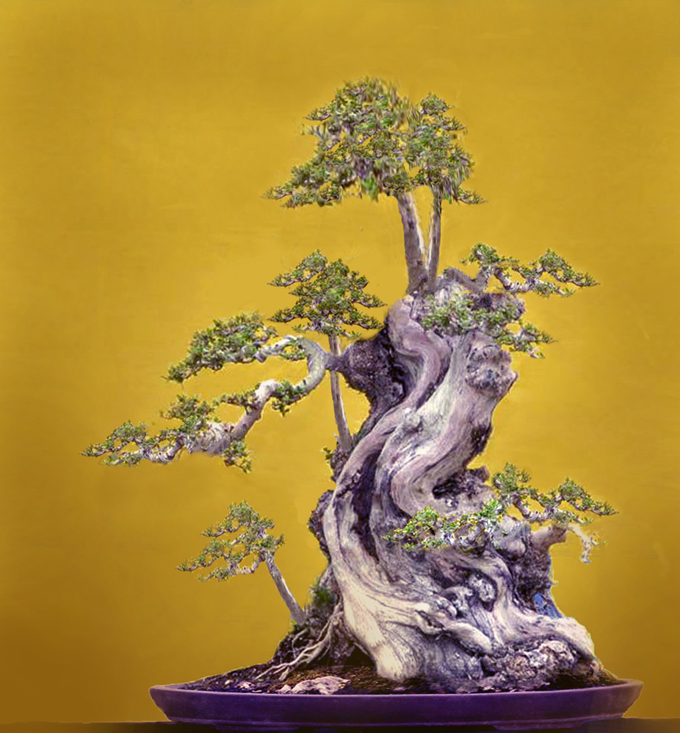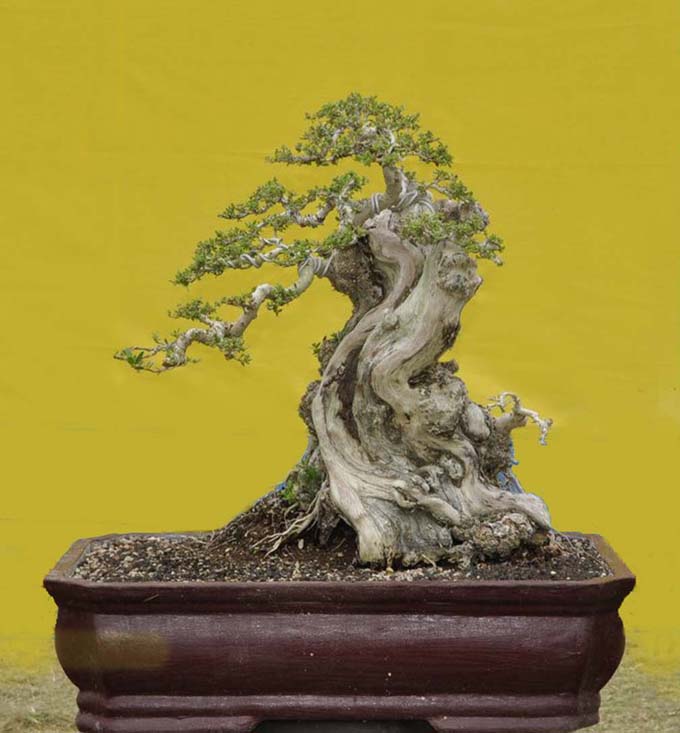 Robert Steven’s simulation of a photo submitted by Wayan (see below).
Robert Steven’s simulation of a photo submitted by Wayan (see below).
What a difference a pot makes
Though Robert doesn’t mention it in his critique (below), introducing a shallow pot, rather than the tree’s clunky and rather unattractive pot (also below), instantly transforms the whole tree. Nothing outside the box, just a simple change that does wonders for a bonsai.
In Robert’s own words
Although the trunk is very interesting, it is quite difficult to turn this tree into a design that ideally portrays a large mature tree. The stump is too bulky, so it is not easy to train the other physical elements to fit it in a proportional manner.Imagine the stump as a hill, and trees are growing here and there creating a unique composition.
Think out of the box! Make a rather “surrealistic” design…
Thanks to Pemphis which we can expect new shoots to easily grow, especially on the gnarled knots; then train every single shoot as a tree following natural phenomena as shown on the simulated picture below. The only tree to add separately is the one on the left bottom; or you can do without it if you prefer.
General comments
There is more than one way to design any bonsai and my critiques and recommended solutions might not always fit your taste and personal preferences, but I always try to give my opinion based on artistic and horticultural principles.
To understand my concepts better, please read my books Vision of My Soul and Mission of Transformation which are available at Stone Lantern.

I like Steven’s approach on this one, although if I had that tree my thought would be to simply grow a much larger canopy for it, twice or maybe even three times the existing size. Keeping the canopy smaller, one could also create interest by doing a profound carving job on the trunk with deep fissures and a combination of dark and see-through areas.
This is a really interesting approach to a stump, using it as a visual mountain with the sprouts trained as trees. A similar solution is in the July/August issue of Bonsai Focus on page 11. It’s a privet, ligustrum ovalifolium and I have a stump of the same species waiting for an initial styling.
Tempting.
I like the new tree…It’s like a cross bred between a regular bonsai and a penjing. but IMHO the new pot doesn’t do justice in creating a convincing landscape scene with the stump as a hill. I have seen some of Robert’s work, and I would like it better if his “usual” shallow pot approach in creating penjing would be used with this tree as well.
Thanks Al, Carol & jun,
jun, I think there may be some confusion about which pot is which. Unlike most places, I always put the ‘after’ bonsai at the top of my blog. Mostly this is because this is what everyone sees first and I want what everyone see to be the best. So the shallow pot version is Roberts simulated bonsai and the other one is what was submitted by Wayan.
Wayne,
All due respect, a wooden mountain (Oh to live on Sugar Mountain – Neil Young), please! I only agree with the shallower pot idea, but the penjing (bogus in my opinion)? I agree with Al on this one. A large gnarled canopy befitting the exquisite trunk and nebari of this tree would be more “real.” I love Robert Steven’s work on the many Santigi that he owns, but they have a natural aged appearance. Too bad that we don’t have access to ancient, oceanside Santigi here in the US. I think thay make the most aged, almost “spooky” bonsai that I have ever seen.
Respectfully,
Owen
Thanks Owen, as I always mention at the end of my critique : “General comments
There is more than one way to design any bonsai and my critiques and recommended solutions might not always fit your taste and personal preferences, but I always try to give my opinion based on artistic and horticultural principles.”
Anyhow, in this case, I have few messages to pass on :
1. There are always solution to handle any material to optimize the design, ideas are unlimited. If there is any “objective” issue, we can still improve by giving a “subjective” touch as to this bonsai.
2. As I always emphasize in any occation, I don’t recommend people to camouflage their bonsai by giving a densed foliage to cover the poor ramification structure. I always emphasize the importance of good and ideal ramification structure. In the case of this bonsai, it’s difficult..or mostly impossible to train good ramification in ideal proportion to portray a big old tree in nature. Ofcourse we have another option to carve out most of the deadwood to decrease the bulky image of the trunk, then train a bigger canopy to fit; this is another true option. But again, in the case of my simulation, I simply want to show other “unusual” solution.
3. With the “unusual” solution, I want to stimulate the creativity, imagination instead of simply trap our mindset in the “usual” convention. In fact, we can see many of such design in Chinese penjing (read “Chinese bonsai”)..or we can see similar design of raft style bonsai with the over-sized stump base which give an imagination of trees growing on a small hill instead of giant stump. Art is about imagination and symbol…
So, if you prefer to style this bonsai as a single big tree, I’d suggest to carve out most of the trunk, then have a good patience to train the ideal ramification..but NOT simply create a big canopy to fit the trunk.
Jun, you are right, such design always need a shallow pot to suggest the atmospheric image and a nature ilusion. The pot in my simulation might me too shallow, we can use a slighly deeper pot, then it should be slighly wider to the left to give more empty space for the visual balance…
Hi Owen,
Yeah. No Santigi here. Our loss on that one. Though I wonder if any have found their way into the states (no mean feat given USDA draconian regs). My guess is they might do okay on the coast of south Florida. I’m told they require regular sea water spay, so a greenhouse in temperate zone probably wouldn’t work unless you have access to ocean water (maybe you could devise a salty spray?).
Here’s something from Leo de Leon on Pemphis that appears on bonsai4me.com: http://www.bonsai4me.com/AdvTech/ATPemphis.htm
Leon says you can buy seawater (formula) at pet stores. So there’s hope.
Here’s a discussion on Pemphis in the US on bonsaitreeforums: http://www.bonsaitreeforums.com/forums/showthread.php?1935-Pemphis-acidula
Although you have the access to import, but Pemphis can hardly survive during transportation, it’s too sensitive eventhough with soil. Another main problem is the climate, Pemphis need full sun, high humidity and wind.. On top of that, there is special technique in maintaining to avoid dying back especially the finished bonsai. You may have it grow well during the training stage, but once the foliation is formed in proper ramification, you will face the real crusial problem in maintaining. This is the stage when many collectors apparently lost their Pemphis bonsai even in Indonesia.
I will write an article about this. Still lots of people think growing Pemphis need sea-water..in fact, it’s not really the case. Climate, then caring and maintaining are the key factors…
More a question than a critique. I notice in the top photo a number of straight branches which were not on the tree in the larger pot. One is bottom left, one is mid-left and two at the top. Were these grafted on or were they allowed to grow out for future design. The lack of movement in these straight branches really mar the design of the tree.
The shallow pot does make the overall composition look much better but the straight branches are jarring. BTW, compared to my poor trees, I would love to have a tree even close to this, so my critique is mixed with envy. :-)
Oh, wait, were these photoshopped? If so, why?
Tom,
The top one is a simulation. If you look at any of Robert’s critiques, you’ll see that that’s how it’s done. Someone sends a photo and Robert redesigns it in photoshop, with an eye to improving the tree and perhaps imparting some valuable insights along the way.
Seems Tom hadn’t read the whole posting. However, thanks for the comments and any questions are welcome !
it is a beautiful idea, make the trunk as hill. the imagination is surrealistic. what an alternative. i love this idea.